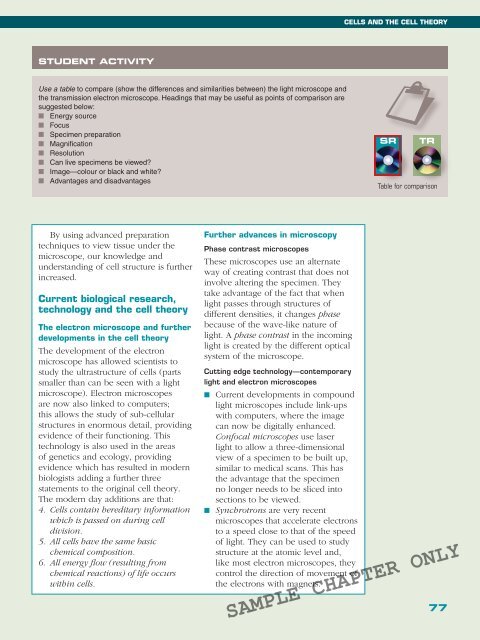BIOLOGY IN FOCUS
BIOLOGY IN FOCUS
BIOLOGY IN FOCUS
Create successful ePaper yourself
Turn your PDF publications into a flip-book with our unique Google optimized e-Paper software.
CELLS AND THE CELL THEORY<br />
STUDENT ACTIVITY<br />
Use a table to compare (show the differences and similarities between) the light microscope and<br />
the transmission electron microscope. Headings that may be useful as points of comparison are<br />
suggested below:<br />
■ Energy source<br />
■ Focus<br />
■ Specimen preparation<br />
■ Magnifi cation<br />
■ Resolution<br />
■ Can live specimens be viewed?<br />
■ Image—colour or black and white?<br />
■ Advantages and disadvantages<br />
SR<br />
TR<br />
Table for comparison<br />
By using advanced preparation<br />
techniques to view tissue under the<br />
microscope, our knowledge and<br />
understanding of cell structure is further<br />
increased.<br />
Current biological research,<br />
technology and the cell theory<br />
The electron microscope and further<br />
developments in the cell theory<br />
The development of the electron<br />
microscope has allowed scientists to<br />
study the ultrastructure of cells (parts<br />
smaller than can be seen with a light<br />
microscope). Electron microscopes<br />
are now also linked to computers;<br />
this allows the study of sub-cellular<br />
structures in enormous detail, providing<br />
evidence of their functioning. This<br />
technology is also used in the areas<br />
of genetics and ecology, providing<br />
evidence which has resulted in modern<br />
biologists adding a further three<br />
statements to the original cell theory.<br />
The modern day additions are that:<br />
4. Cells contain hereditary information<br />
which is passed on during cell<br />
division.<br />
5. All cells have the same basic<br />
chemical composition.<br />
6. All energy flow (resulting from<br />
chemical reactions) of life occurs<br />
within cells.<br />
Further advances in microscopy<br />
Phase contrast microscopes<br />
These microscopes use an alternate<br />
way of creating contrast that does not<br />
involve altering the specimen. They<br />
take advantage of the fact that when<br />
light passes through structures of<br />
different densities, it changes phase<br />
because of the wave-like nature of<br />
light. A phase contrast in the incoming<br />
light is created by the different optical<br />
system of the microscope.<br />
Cutting edge technology—contemporary<br />
light and electron microscopes<br />
■ Current developments in compound<br />
light microscopes include link-ups<br />
with computers, where the image<br />
can now be digitally enhanced.<br />
Confocal microscopes use laser<br />
light to allow a three-dimensional<br />
view of a specimen to be built up,<br />
similar to medical scans. This has<br />
the advantage that the specimen<br />
no longer needs to be sliced into<br />
sections to be viewed.<br />
■ Synchrotrons are very recent<br />
microscopes that accelerate electrons<br />
to a speed close to that of the speed<br />
of light. They can be used to study<br />
structure at the atomic level and,<br />
like most electron microscopes, they<br />
control the direction of movement of<br />
the electrons with magnets.<br />
SAMPLE CHAPTER ONLY<br />
77
















